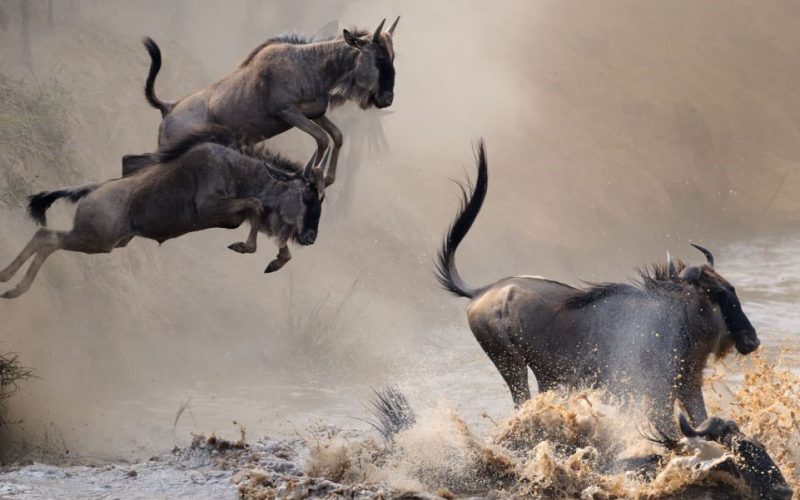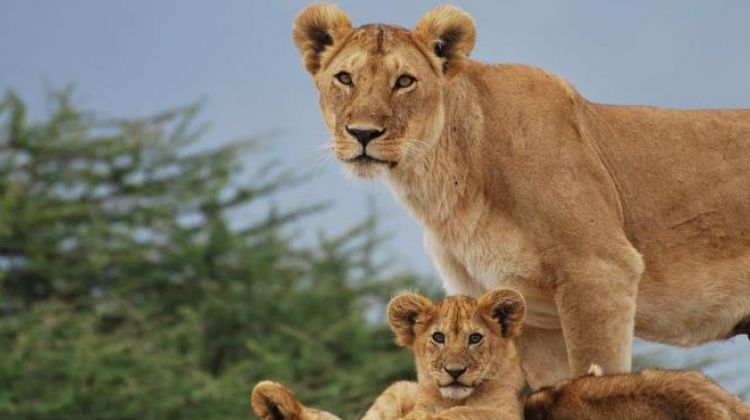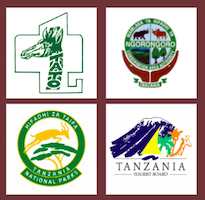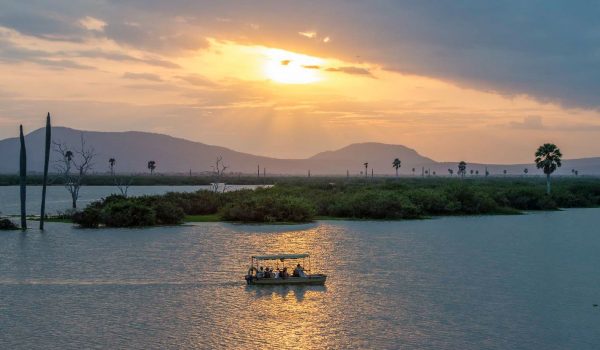Serengeti wildebeest migration
- The short rains begin around early November. A little after this, in late November and December, the herds of the wildebeest migration arrive on the short-grass plains of the Serengeti. These are south and east of Seronera, around Ndutu and include the north of the Ngorongoro Conservation Area.
- MORE DESCRIPTION
Dispersed across these plains, wildebeest and zebra are everywhere – feeding on the fresh, nutritious grasses. They stay here through January, February and March, with most wildebeest calves born in a short window around February. Gradually they spread west across these plains, then around April they start their great migration north.
By May the Serengeti’s wildebeest all seem to be moving north, migrating to seek fresh grazing and water. The area around Moru Kopjes and west of Seronera is then hectic with a series of moving columns, often containing hundreds of thousands of animals – joined by many zebras, and a scattering of Thomson’s and Grant’s gazelles.
Some of the migration then head due north of Seronera, but most are usually further west. Around June the wildebeest migration is often halted on the south side of the Grumeti River, which has some channels which block or slow their migration north. The wildebeest then congregate there, in the Western Corridor, often building up to a high density before crossing the river.
The river here is normally a series of pools and channels, but it’s not continuous – and so whilst they always represent an annual feast for the Grumeti River’s large crocodiles, these aren’t usually quite as spectacular as the crossings of the Mara River, further north.
The wildebeest migration continues moving northwards during July and August, often spreading out across a broad front: some heading through Grumeti Reserve and Ikorongo, others north through the heart of the Serengeti National Park.
September sees the herds spread out across the northern Serengeti, where the Mara River provides the migration with its most serious obstacle. This river gushes through the northern Serengeti from Kenya’s adjacent Maasai Mara Game Reserve. Watching the frantic herds of the wildebeest migration crossing the Mara River can be very spectacular; there are often scenes of great panic and confusion. It’s common to see herds cross the Mara River north on one day, and then back south a few days later.
By October the wildebeest herds are migrating again with more accord: all are heading south, through western Loliondo and the Serengeti National Park’s Lobo area, returning to the green shoots which follow the rains on the short-grass plains of the southern Serengeti in November.
Then the whole Serengeti Wildebeest migration starts again The natural amphitheater formed by the extinct volcano at Ngorongoro is a similarly bountiful game viewing environment with an abundance of animals, including the Big Five – Buffalo, Elephant, Leopard, Lion and Rhino – gathering around its watering holes.
These prime animal attractions mean the Northern Circuit has become increasingly busy, but it is still possible to escape the crowds and find a quiet corner if you know where to go among the circuit’s national parks, game reserves, conservation areas and private concessions.
There are even small sections of the Serengeti that are out of bounds to motor vehicles, allowing walking safaris. Tarangire National Park and Lake Manyara National Park live in the shadow of their more well-known neighbours but both offer superb game viewing away from the crowds.
Aside from the animals, the Northern Circuit also allows the chance to experience ancient, largely unchanged human civilisations such as the pastoralis Maasai and Samburu tribes as well as the Hadzabe that hunt and forage around Lake Eyasi and the Southern reaches. It’s possible to go back to even further earliest evidence of the existence of our human ancestors at the OLduvai Gorge, where hundreds of thousands of fossilized bones and stone tools in the area date back millions of years.
For visitors up for a challenge, there are a range of testing mountainous peaks. Chief among them is Mount Kilimanjaro, the highest peak in Africa and the highest free-standing mountain in the World. Getting to the top will take at least five days of pole-pole (slowly-slowly) progress with experience guides to its 5,895 m (19,340 ft) summit. Climbers can acclimatise to the altitude peaks such as Mount Meru and active volcano Oldonyo Lengai (‘Mountain of God’ in Maasai Language)

- EXPECTED TO SEE




- ENQUIRE THIS TOUR
Ready to plan your safari? Your tailor-made African adventure starts here.
Let us take care of all the planning.

- TANZANIA TRAVEL SPECIALIST
- +255784991576
For more information about Tanzania Safari and Tours please visit our main website
- WILDEBEEST MIGRATION PACKAGES
- RELATED TOURS










